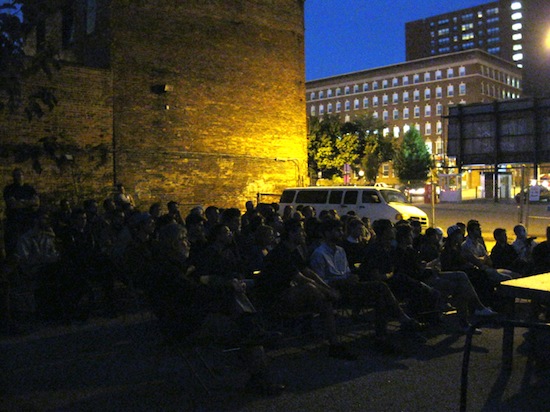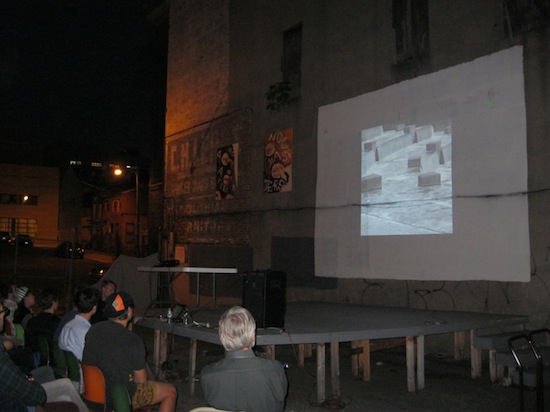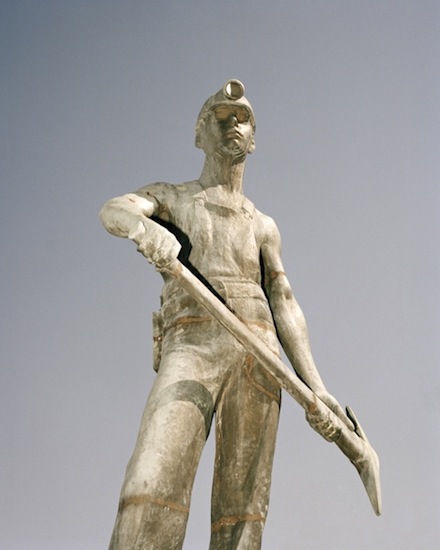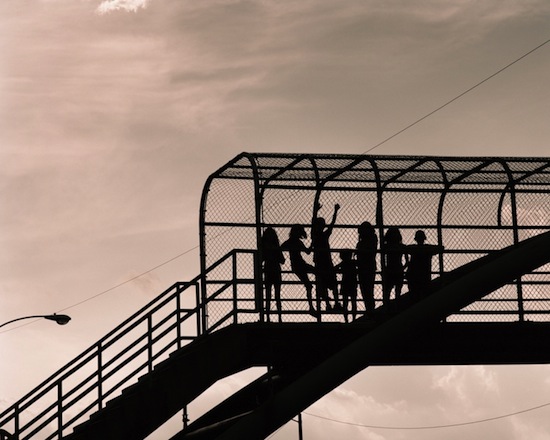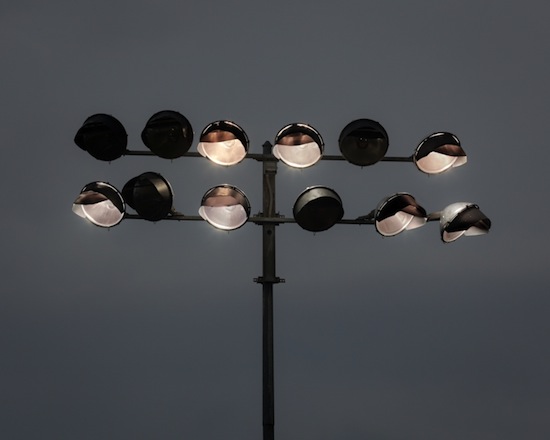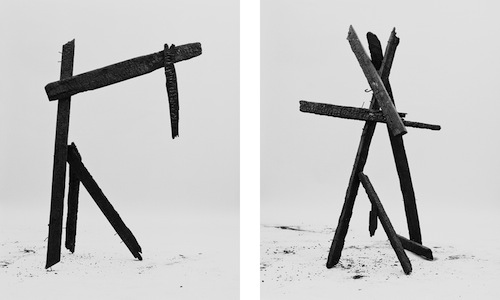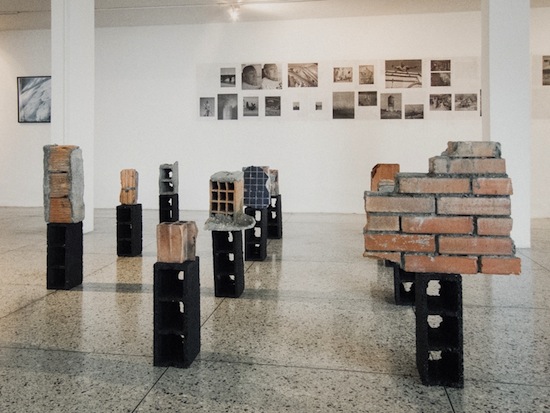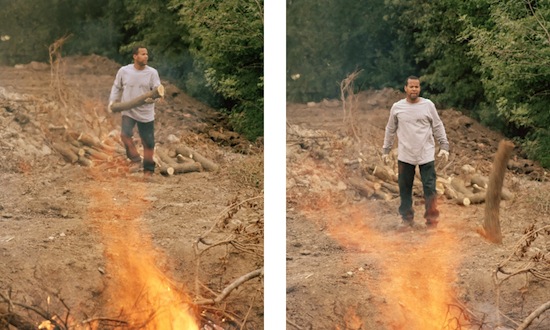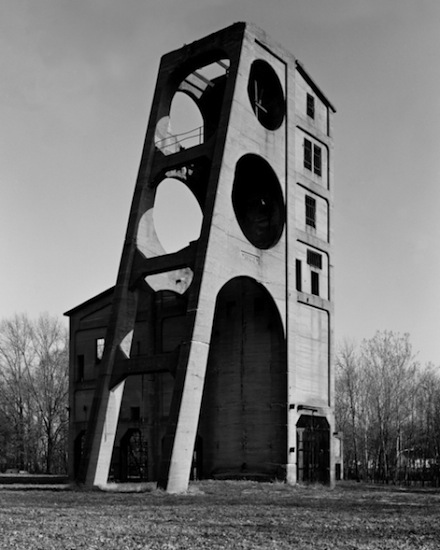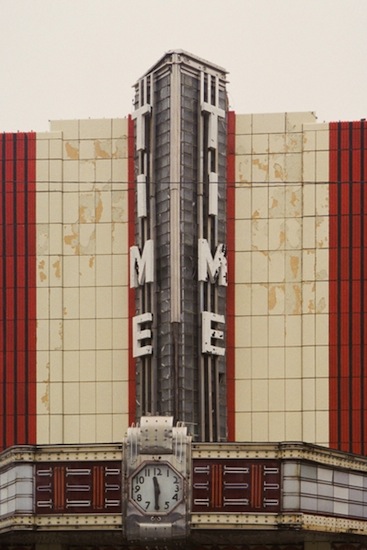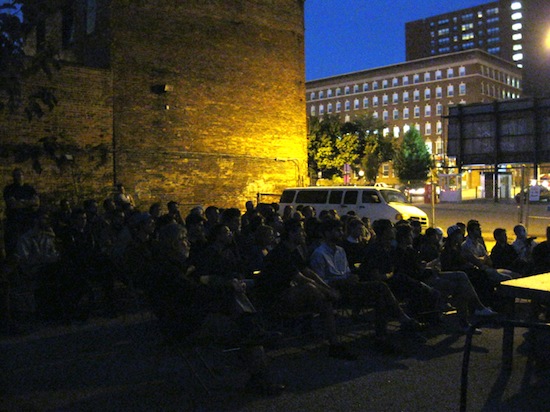
The opening reception of Good Light ’13 at Current Space had a great turnout. Over a hundred people came to the inclusive event to see Daniel Shea’s lecture and the slideshow of works by various participants.
Shea used the slideshow of his own works, in order of their development, to move through a roundabout explanation of his inspiration and interests. He tended to explain his specific processes of making pieces, then the historical or conceptual context that inspired them. He spoke articulately, but in a personable tone, breaking form to gather his thoughts at some points during the presentation.
Shea’s work is constructed from remains of 20th century American industry and the culture that evolved from it, captured in photos and physically worked in sculptures. In galleries, he presents debris from once-industrial sites and abandoned pre-fab housing, either as-found or built into new forms. These elegiac pieces invite a critical perspective on the common attitudes towards these materials’ history. Chilling objects of ruin encountered in the landscape, such as a pile of burnt wooden beams, take on a new formal life in Shea’s art space. The photographs are presented similarly, as reconstructions of found subjects embodying postindustrial entropy.
Shea has created a book called Blisner, Ill., full of photographs taken at various locations in Illinois, united as a single town called Blisner, which Shea fabricated to offer a cohesive setting for the entire series. Knowing that the images are tied together by a fiction activates the series, allowing me to explore Blisner through my own prior knowledge of postindustrial rust belt towns, and imagine narrative to the pictured peoples’ lives. The tension between reality and narrative always complicates documentary projects, but Shea has chosen to evoke an overall socio-economic reality through outright storytelling, rather than through recordings contingent upon a single real place. Presenting these documents together as an Everytown, he leaves us the authority to fill in the blanks between the photos.
By this process, Shea begins a practice to mythologize the history of his subjects, and avoids a nostalgic outlook in favor of a post-traumatic one. He never portrays “good old times,” rather presenting remnants of a complicated and devastating history of industrial undoing. This history necessarily acts as an example for present day society. The talk left me shaky about Shea’s own perspective of his work, which he began to express more passionately towards the end of the talk and during the Q&A. He seemed slow to break from the academic rhythm of process description and conceptual reference. Though it skillfully rationalized his elegant works, Shea’s lecture could have engaged the audience more with his personal ideas about historical low standards for sustainability, and more specifically proven the ways in which the history of the rust belt “implicates the present.”
/////////////////////////////////
Artist Talk by Daniel Shea @ Good Light 2013, Sept. 27
Lecture and slideshow in back lot of Current Space, 35 minutes
Transcribed by Mac Falby (images not in order of original slideshow)
—————————————–
I’m gonna sit because there’s a lot of people here, and it makes me nervous – actually if half of you would just leave I could do a much better job, or if someone could give me some wine…
Okay so, admittedly I prepared this talk based on my thesis research, which I just completed at UIC, and I had to present formally as part of my defense. The talk I had prepared is very kind of dry and academic, and I’m realizing now this atmosphere is much more casual, so I’m going to try to deviate a little bit from my script and not just read at you for 25 minutes. But what I’d like to do on some level is weave in and out some of the areas of content I’m working with: primarily working with fiction, mythology, and post-industrial detritus, and finding different narrative strategies for both presenting sculptural and installation-based work, and book projects that are primarily photographic.
This is a work in progress with a friend of mine, John, who’s become a friend of a character in this work of fantasy fiction in this cyber-punk dystopian future. This work is not nearing completion at all, but it’s something I’m working on, in progress.
So, Robert Smithson is hugely influential for me. A lot of my students are here right now, and I talk a lot about Smithson in my class. He wrote an essay for an early issue of Art Forum called “A Tour of the Monuments of Passaic,” and he describes the suburban landscape in New Jersey as these extinct dinosaurs. He finds all this in-progress construction in the suburbs of New Jersey. In that essay, he takes the bus and goes out there and makes these pictures, and he formalizes this idea of a ruin in reverse, wherein the ruin isn’t existing in the conventional sense, but it falls into ruin as it’s being built. He says that all these elements in this dialectical landscape are the opposite of the Romantic ruin, because the buildings don’t fall into ruin after being built, but rise into ruin before they are built. Blisner is also a town I’m familiar with, similar to Passaic, in that it’s a blighted place, it’s incomplete, it’s unfettered, and ambivalent. I have a quote from George Simmel; he says, “Architecture is the only art in which the great struggle between the will of the spirit and necessity of nature issues into real peace, in which the soul in its upward striving and nature in its gravity are held in balance.” Rose McCulloch also writes about this paradoxical new ruin that projects an aura of, I guess a kind of deep mortality. The new ruin doesn’t have this prerequisite ruined surface, and thus it’s kind of a confusing thing to encounter in the landscape.
These images are from a series called Daylight, and are simply photographs of lights that are left on during the day. They illuminate specifically parks, consumer parking lots, and industrial yards. The photographs are made by underexposing these lights during the day, and they’re printed quite large, so the inner mechanisms of the lights are made photographically visible. It’s not something that is optically visible, but relies heavily on the photographic process. I’m interested on some level in a simple proposition with these, which is: what happens when the lights are turned off permanently?
I’m interested in ruins not only as they look backwards to a historical moment, but how they also implicate the present. Interested specifically in their temporality in that sense; they’re kind of enigmatic, and they slip. This is a slide of an installation I did at Level Three gallery in Chicago. For a few years I’ve been working with this industrial detritus as it exists in this landscape of disuse. I’m interested in how, when something’s conceiving context is destroyed or changed, the meaning of the thing itself is also destroyed or changed. In that post-industrial context specifically, objects become seemingly available for reconfiguring or repositioning. Ah, someone brought me wine. I think a lot about the photographic index, and how it relates to sculptural materials. These materials in this work function in a way similar to the photographic index, in that the inherent surface qualities of the installation materials shift the focus from being inside the gallery, the non-site, to the external unknown site, where the material conditions of the object itself were affected by time and weather, and other things that we might imagine. So there’s a shift of focus in that sense, and again, a kind of slipping. This piece is a series of ten photographs. The materials are formally arranged to suggest an iteration, rather than a final or new configuration. I was interested in these installed with an attempt to mystify the relationship between their material and their history and labor. There’s always implied in specific narrative histories with any material that is reused from these industrial sites, and I’m interested in how they slip between a specificity and something more anonymous. This was the original piece I made when I found this wood; I originally found this wood at a site that had become a staging ground for some photographic works, and a contractor presumably had dumped what I thought was a burnt-out deck at the site. In this amorphous reconfiguration, that was my first attempt at dealing with it as a work, and also working through the material and trying to tease out a hidden life in this pile of stuff that I had just found.
Iterations of wood, two of ten photographs
The second iteration was this project – and this is the piece installed in the gallery; the work is a set of ten photographs, the two spaces in the bottom right-hand corner being a kind of “dot dot dot…” I picked the wood and I built a makeshift studio and used the wood until it ran out, and you can see a visual trace of that process in all of the photographs. Then, the final iteration is, on some level, I think of it as the grave, and the grave being the pedestal, or the stage, all being synonymous terms for this piece. The wood was treated with a final coat of spray paint; it resembled a deep charcoal, it wasn’t necessarily clear that it was spray paint, but I was interested in using spray paint as an act of narrative performance, sealing its myth. The pedestal, or the stage, or the grave, is propped up by these cinder blocks, purchased new, thinking about the cinder blocks actually being the prop, or pedestal for the pedestal itself. And in another part of the gallery, that was flipped. The cinder block which served as a pedestal in the previous piece then becomes the object here, placed on a traditional pedestal. One cinder block originates from the site of the post-industrial wreckage for this fictional site if you believe in what the work and the show is presenting to you, and the other comes from the pre-ruined site of Home Depot.
 Burned wood on pedestal (in background)
Burned wood on pedestal (in background)
This is from a recent exhibition I had in Chicago, it’s titled Blue Island Nine, being the ninth in a sequence of installations that dealt with materials from this site formerly industrial south-side Chicago area. While working on this, I had a revelation in the studio thinking about how individual components from previous work could be used in future installations in a modular context, and that the trace of their previous reconfiguring was an interesting element in the work, so a lot of this stuff is recycled bits and pieces from previous installations and sculptures. I’m going to get to photography soon, I promise. Can you guys hear me okay? Am I talking too fast? Okay…
Really with this work, I’m thinking about entropy, both out in the world and also in the studio. In the studio context we tend to fetishize practices of sealing performance, permanence, archiving, etc. I have a quote from Marx, which I’ll read for you. In The Fetishism of Commodities, he says, “There’s a physical relationship between physical things. But it is different with commodities. There, the existence of the things qua commodities, and the value-relation between the products of labour which stamps them as commodities, have absolutely no connection with their physical properties and with the material relations arising therefrom.” In this installation, that brown vertical thing kind of functions as a table; it’s about table-height, you can look in it. It contains the pulp of a disintegrated manager’s office that overlooked the factory floor; it’s sealed in resin.
So entropy is hugely important to me too, and it was important to Smithson. Another quote from Smithson that I really love, and I think about a lot: he says, “We take a child and have him run hundreds of times around clockwise in the box until the sand gets mixed and begins to turn grey; [he’s talking about a child running in a sandbox divided into an arrangement of white and black sand] after that, we have we have him run anti-clockwise, but the result will not be a restoration of the original division, but a greater degree of greyness and an increase of entropy. Of course, if we filmed such an experiment we could prove the reversability of eternity by showing the film backwards, but then sooner or later the film itself would crumble or get lost and enter the state of irreversibility.”
This is work I did from a show in Venezuela; I did a site-specific piece at a museum down there. I was invited to consider the detritus in that landscape, which is not unlike something you might find on the south side of Chicago, but there I found the ruins to be more easily reappropriated as interesting social spaces. So, people had taken it upon themselves to set up improvised shops or homes or shelters or whatever, and it was more open there. Under these large modern ruins was all this social activity that was, in the areas I’d been working with, reserved more for teenagers hanging out, people doing graffiti, or sometimes people used it to live. But these materials were available, and also the building materials used in more contemporary architecture, more prefab housing, in this town I was in in Venezuela, were cheaper, and the process of growth and decay was accelerated. So I’d mixed in both the detritus from these large modern architectural ruins and from the more prefab detritus that I was finding.
So, Blisner Illinois is a book project that I worked on for a long time, and it provides an account of what happened in and what remains of a single rust belt town during the process of deindustrialization. The project itself is conceived of as being a book, so the book itself is the work. It begins with an early history of the discovery of a certain type of coal in southern Illinois, and it moves through a century of both mine disasters and great industrial prosperity, and it ends ultimately with this brutal and sudden fallout from the de-industrialized moment. It’s a familiar narrative for anyone who grew up not only in the midwest and the rust belt, but in any formerly prosperous industrial city. It contains a dense chronology of this town, Bilsner. The town itself is scattered with the wreckage of this former era. Again, the meaning of that detritus that’s changed from something of clear utility, that was used for a specific purpose at one moment, to something more horrific and ambiguous. I’m interested in how, in a blighted place, the history of labor and industry is contained in these objects and symbols that scatter the landscape, and what they mean now that they’re conceiving context that’s been lost or shifted. I think of the people in this town as existing in an equivalent social space.
I spent my time in this town looking for specific archetypes that, through repetition, could be surrogates for reoccurring characters that might exist in any kind of work of fiction. The inhabitants of this town worked primarily in the coal and cement industries and built the railway infrastructure of an early midwest; and then of course, were victims of the systematic deindustrialization of the American workforce. [Marx] is important to me because he deals a lot with how there’s an interesting social relationship between the people who make things and their social position in the culture at large, and that’s primarily an abstraction, and it’s always been very interesting to me.
I’ve always been specifically obsessed with coal – for years I worked on a more standard social documentary project about the coal industry, which led me to this work. Coal is raw and primitive and readily available, and in recent years I was really considering coal in the context of entropy. It’s not only connected to a history of mining and industry, but also an unimaginable history of the world in a sense, because it’s a literal fossil for history on some level; it has this god-like presence. It’s really interesting to photograph too – it consumes light in this really specific and beautiful way. It has such a loaded history, and it’s still talked about in this contentious way, both politically and in the culture of these regions. I’m interested in how the surfaces of this town render history visible in a very specific way. Again the landscape of ruin is also important in this work. Often what remains is the scaffold of architecture where the bits and pieces, the stuff you have to fill in when you’re looking at this kind of thing, really happen in your imagination. You imagine a history, it’s a very narrative act. These structures die the moment they cease to produce. On some level their instability is masked by their massive physical presence. I think they take on this historical amnesia.
This is an excerpt from the book – there’s all kinds of text-based work in the book as well. This is a booster club pamphlet from Cookland County, which is the county that houses this town Blisner, and it says at the bottom, “Burn Cookland County Coal, it’s better. Buy Cookland County Coal, it’s cheaper.” The book contains different kinds of documents – some are found, some are altered, some are fabricated completely. A lot of historical documents, archived materials, content, and design were pulled from books used to tell the history of this town previously, and I just pulled a lot of little bits and pieces from different sources to create the content in this new book. I worked closely with a designer, Morgan Brill, on doing that.
(Now, a twist)
So, Blisner is a work of fiction. As a strategy, I was thinking of this project both as both expanding on the artist’s monograph and also the research document, thinking specifically about what kinds of legibility those kinds of books encourage when looking at them. This approach was also reflected subtly in the extract for the wall work when I show the work as a wall exhibition. This ungrounding or unframing of points of reference that’s used in the book is also employed in the actual construction of the narrative. Again, Blisner’s not a REAL place. It’s a fictitious one based on real places, and the conflations of real places, both in southern Illinois and south Chicago. I was really interested in using fiction as [what I’d describe as] a device for a viewer to attempt to understand exactly how this titan mythology of American industrial prowess came to be. Mythology is a double-edged sword; on one hand, in this act of mythologizing, politics and specificity are lost in the myth, and on the other hand, you have this lush arena of fiction and possibility that’s opened up. But of course, there are always realities that can give birth to the conditions that mythology can exist within. I’m interested in how this history is something we’re so familiar with and how it can embed itself in this mythological form.
With this project, and with a lot of the current work I’m working on that is photographic, I really embrace terms like post-documentary and expanded documentary. I’m not interested in necessarily totally riffing on the documentary form, but using it to reveal it’s inner mechanisms in a critical context. And really, fiction is a frame of working more than anything else, it doesn’t necessarily change the working process. Although I think it freed up the way I was thinking about traveling and where I could go and what I could include under the umbrella of a certain project. If you see the book, it’s not exactly clear that it’s a work of fiction, and I think that at the moment when that is revealed, it reframes the content in a way that I hope is interesting. Again, ultimately, this book project and this work is about things that continue to happen and have happened to people, and I’m very interested in staying true to a history that seems within reach, and that I think is important to talk about. I was thinking recently about summarizing my interest and what is driving underneath this work, and why I’m interested in dealing with this stuff. I think it’s because a lot of this stuff has happened in recent history, and it hasn’t been dealt with in a way that matters. There’s a lot of bits of disparate information out there, be it research or artistic projects or sociological projects, but as a whole nothing has been done really substantially with the stuff that exists out in the landscape. I mean, things have definitely been done, but I don’t think weird enough things have been done, within the context of something artistic or that reimagines the history that is embedded in these things. So I think that’s a driving factor in the work on some level. Also, I’m interested in taking the stuff and using it outside of what I imagine to be some kind of arbitrary modes of classification, and defining it’s own context for the work to exist in.
So that’s my last slide, I also have some new stuff from the new book I’m working on, it’s called Blisner, IL, the contemporary version of the abbreviation of the state, as opposed to Ill.. It’s a subtle shift, but reframes this project as a historical document, much in the same way historical documents are contained in this work. It’s presented much more formally as an artist’s monograph, structured in chapters. So I have some work from the first chapter that I can show, I don’t know… should I put that up? Okay.
This work is very photographic. I think this is perfect to show right now. This first chapter deals with the image of the postindustrial town; I’ve been to about thirty towns in southern Illinois at this point, that all share the interest in maintaining the veneer of a once industrially prosperous moment. So imagine if you’re standing outside the town, you’re on a hill holding a postcard of this town from 1930 – you hold it in front of you and then move it – from a distance the town would basically look the same, but it’s kind of an interesting thing for me what these places do. When you get up close and you look in the windows, the seams of these places reveal themselves in obvious, sometimes subtle ways. These are all photographed in those spaces of these downtown southern Illinois towns. I’m working in reoccurring characters also, like I did in the last book project.
I guess at this point if someone has a question I can talk a little more… or I can just stop talking.
//////// Q&A ////////
(A man speaks from the crowd, indistinct on my recording, asking about the role of “time” in the work)
(DS:) Time? Absolutely, I’m looking backwards constantly. I have a troubled relationship with nostalgia, from looking backwards so much, but I think dealing with this stuff that is left over says a lot about [the present; this stuff] now implicates the present in an interesting way, and can maybe project something onto the way we deal with the future. Also, I’m really interested in the mechanism of history, and how history is told and contained in books, objects, and stories. I’m interested in playing with slippage, because I don’t think time/history are as linear as we think of them. Yesterday I was talking to a friend about how we think of history as being recorded in a convenient chronology, dotted by specific events that happened in a certain order, and define certain times. I think it’s much more expansive, existing on micro and macro levels simultaneously in a way that makes it complicated and difficult to understand, but also really amazing. Actually, in this book, there’s lots of images of clocks, so very literally addressing time.
(The same man replies, indistinct)
(MF:) What is one way that you think this kind of history implicates the present?
(DS:) That’s something I think about a lot. In the broadest sense, we did things sloppily. We used things sloppily, we did stuff quickly, and it was conventional to think of people as disposable. There’s a legacy of that in globalization. I think a lot about how the world works today – the market and all these other things. There’s a very direct lineage to this moment of deindustrialization specifically in terms of a collapsing of international economic boundaries that once existed. If anything, [the work] studies the events that led to how the world works today; I don’t claim to know anything about how the world works today, but I have a vague idea sometimes. The “lessons to be learned” thing is not actually a good answer, I don’t know if I believe that. Also, I’m not interested in nostalgia because I don’t think this was necessarily the best time. I don’t think we should go back to making things like this, that’s a fetishistic thought. [This work] doesn’t implicate the present in that I’m suggesting that this moment of industrial prosperity was a golden time or anything like that, I’m actually saying the opposite. That was a roundabout answer, was it medium satisfying? Okay.
(Student in crowd:) Can you describe more about the chapters and how they correlate to specific photos?
(DS:) Sure, it’s both really practical and also an interesting working constraint. Originally, all the projects that are going to be in this book were meant as follow-ups to the broader project – small zines and other publications. This is just a way to organize them. Also, the chapter structure in a book is an interesting way to think about time moving, or establishing narrative between disparate ideas and projects. Also, the work is so wildly different, as a challenge to myself I decided to shoot each really photographic chapter like a different photographer took it on. I’ve actually invited a lot of friends and artists to contribute to the book, and they’re going to have their work in the book; it’s not going to be clear which work is theirs and which work is mine. Again, like some of the strategies I used in the last book, the chapter organization is a way to suggest a convenient organization, but also contain something that makes it difficult to digest.
(Another student in crowd:) I’m wondering if there is a way to take photos that… Well, I’m remembering one specific black and white photo that I think was of a mine, a large monument at this point. I’m wondering if you’ve ever thought that a monument can be less anthropocentric and more focused on an environment itself. So within these ruins, rather than discussing what we did there, perhaps it becomes a celebration of the land itself and the landscape? I’m thinking of some of your earlier photos involving mountaintop removal.
(DS:) Yes, I mean that’s super interesting – so you’re thinking of these things as having meaning outside of a social context?
(Same student:) Yeah, you build these things that eventually become ruined, and it tells not only the story of people who gathered around the spot, but the reason why they were there. So maybe a certain form of architecture becomes an indicator of the thriving land.
(DS:) Totally, ruins are amazing – people like them, go to them, and embed ideology. Architecture is one of the most interesting forms of embedded ideology. Albrecht Speer talked about the theory of ruin value – building things purposefully thinking about how they would fall into ruination. Super interesting, he was the architect of WWII and Nazi Germany. So yeah, I think they’re monuments also. I think what you said was really beautiful, I’m just riffing on that.
Alright, thank you guys for listening and looking.
* Author Mac Falby studies photography and humanities at the Maryland Institute College of Art, Class of 2014.

